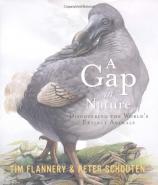A Gap in Nature: Discovering the World's Extinct Animals
Review
A Gap in Nature: Discovering the World's Extinct Animals
What will become of the world? That question is being asked quite a lot these days, particularly with the current economic strains and military and political actions in response to the terror attacks. More to the point: What has become of the world? Why are doing the things we're doing? Harming not only our well-being, but the well-being of future generations? Still more to the point: Why, even when we have a well documented history to look back upon, do we continue to make the same mistakes?
With this current climate we've been feeling these last months, environmental issues have taken a back seat to Afghanistan, Anthrax, and Ground Zero. But, even as we scramble to secure ourselves and find a sense of safety, thousands of other creatures are hiding in small thickets of wood, swimming in murky pools, and flying above shrinking habitats. Endangered species are all around us and their number continues to grow day after day. It's for this reason that A GAP IN NATURE is such an important book --- authors Flannery and Schouten are showing the world its extinct animals, showing us a history that we should heed.
Flannery, the director of the South Australian Museum in Adelaide, and Schouten, a wildlife illustrator who has received two Whitney Awards, have collaborated on a beautiful (and haunting) coffee table book. Filled with facts of long extinct creatures (the Upland Moa last recorded alive around 1500, the Stellar's Sea Cow leaving the Earth in 1768) and more recent animals (April 1965 saw the last of the Greater Short-Tailed Bat, Atitlan Grebe's last breath in 1989), it is a menagerie of the world's extinct animals on paper. Schouten is an exquisite illustrator, highlighting not only the look of the animal, but the character of it. Flannery tells the tales of the creatures with melancholic detail, "The egg, it is believed, was crushed beneath a sailor's boot. Some eighty skins and seventy-five eggs held in museum collections around the world are all that remain of the Great Auk today."
Cataloguing 103 animals from the air, land, and sea, A GAP IN NATURE makes for compelling reading. At the same time, though, it makes you sick to learn that we humans are the main cause of endangered species' ultimate demise. Some of them are beautiful. Take for instance the Greater Amakihi of Hawaii, a small bird with a lemon custard color. "During the twentieth century the thick woodlands that were its only home were felled to make way for sugar cane." Some of them are homely, like the Lagarto, a reptile lost to us in 1914. "The last Lagarto captured by a collector was taken by a German in 1914. The species may have survived a little longer, however, for the Cape Verde Islanders reported occasionally seeing them until the 1940s." Whether they be beautiful or homely, they were important creatures in the web of their ecological community. Now they are lost forever.
Lushly illustrated, engagingly written, A GAP IN NATURE works on two levels. Firstly, it's a eulogy for the creatures, whether it be the Terror Skink or the Thylacine, it laments their absence from our world. But it also has hints of optimism. We know that this can't continue. We know we have to save all the creatures, for our home is their home. If not, in another 50 years, another extinct animal book will be published. Will the Sumatran Tiger be in it? The Snow Leopard? The Manatee? The Giant Panda?
Reviewed by Jonathan Shipley on October 7, 2001
A Gap in Nature: Discovering the World's Extinct Animals
- Publication Date: October 7, 2001
- Genres: Nonfiction
- Hardcover: 192 pages
- Publisher: Atlantic Monthly Press
- ISBN-10: 0871137976
- ISBN-13: 9780871137975



